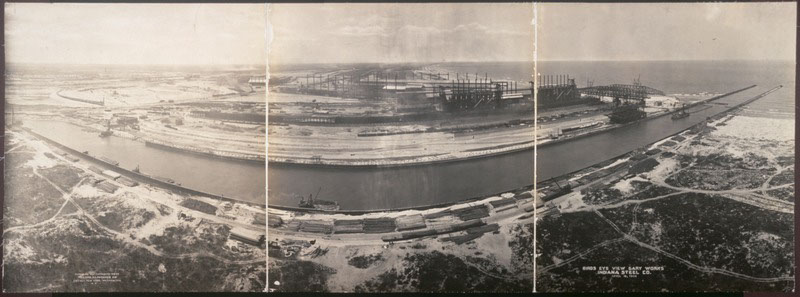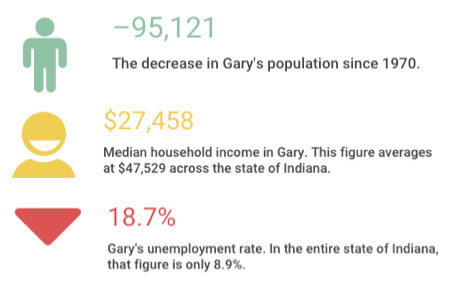Community of Opportunity The realities of Gary's Public schools
Think for a second about what first comes to mind when you hear mention of Gary, Indiana...got an idea? Most likely, the image you have in mind is not a positive one.
My first impression? I entered Gary's West Side Leadership Academy – one of the area's three public high schools – one morning in late August. Like any other school, the walls reflect the students. Murals line the hallways, artwork is plastered all over individual classrooms, banners hang proudly in the gym, displaying dates of championships past. But none of these are the first thing I notice when I enter the building: just steps from the parking lot, through two sets of doors, I cross under a single metal detector – and that’s when I feel the drop.
Something is leaking, causing a slow drizzle from the ceiling tiles above. It starts small.
Staff slowly file in through the front doors. If they notice the leak, they don’t acknowledge it. But a puddle has begun to form on the floor...and it’s growing bigger. A custodian eventually appears, sops up the puddle with an old rag, and slips a bucket carefully underneath the hole in the ceiling. As the hour passes, more staff pour in, and they easily sidestep the bucket – plus the two others custodians have added as the leak has multiplied. The sound of the leak is muffled by conversations and squeals of delight exchanged between coworkers reuniting for the first time since school broke for summer.
It’s a weird sort of metaphor for what’s going on in the district housing the building: the Gary Community School Corporation. There are plenty of holes – financial, physical, in some cases even instructional – and although community members are aware, they seem immune to the problems.
Unless you live in Northwest Indiana – or even if you do – what you hear about the city of Gary usually comes in the form of news reports about crime, dwindling industry, or most recently the failing schools.
But the perception of Gary and the reality appear to be in a sort of disconnect: many residents really see the school community as one with a lot of promise – they seem to have faith in what district administration, teachers, parents and students are trying to do to lift up the city around them.
Here's the perception...
Driving through the neighborhoods surrounding Gary Community schools, you pass a fair share of homes with boarded-up windows. If you've ever driven through the Skyway to exit Indiana on the way to Chicago, you might be familiar with the worn down smokestacks. The blight undoubtedly gives off a certain impression. Gary’s appearance – like many headlines coming out of the city – contributes to the reputation that precedes its name for outsiders. You may have even heard people affectionately refer to Gary as the “armpit of America” before...ouch.
Like most urban centers, Gary deals with its fair share of social issues – violence, crime, poverty. What makes this city’s situation seem so much worse can basically be summed up in one word: economics.
Gary used to thrive. Back in the heyday of U.S. Steel, people flocked to Gary in droves for manufacturing jobs – the population in 1970 sat at just about 175,000. Almost half of Hoosiers living in Northwest Indiana made their living in the manufacturing sector. Those who didn’t found jobs in retail, education, and healthcare.

The same can’t be said today. The steel industry isn’t booming as it once was. People have simply moved out, taking with them valuable tax dollars and leaving behind about 9000 abandoned buildings. And the population has been slashed by more than half. If you think that’s bad, the city’s employment rate is down 70 percent from 1970. Gary now accounts for one-quarter of Northwest Indiana’s unemployed.
Local business leader Eddie Melton says as a result, the area has suffered financially – the city doesn’t have the dollars it once had to maintain property and streets, and to do the things that government would typically do.

"When you have almost half the population that you once had, that’s a significant impact," Melton explains. "When you have your number one employer shifting and changing and not hiring like they once were, you have to figure out what’s going to be your new economic base, and I think Gary is still trying to figure that out."
But Melton – also northwest Indiana's representative on the State Board of Education – adds that no matter their city's situation, there's a pride in Gary that’s never going to change.
"I think historically, Gary and the residents had this pride about their schools, where they grew up, where they graduated from," Melton says. "Everyone loves their alma mater."
...Here’s the reality
But many of Gary’s lifelong residents will tell you differently, pushing the old adage: “you can’t judge a book by its cover." One of them is state Sen. Earline Rogers, D-Gary. She says the district she represents is deeply misunderstood.
"I think people don’t understand Gary," Rogers says. "There is just a renewed hope that I’ve seen in the community, in terms of everybody wanting to pitch in to make things better. And I don’t think that enough people have seen that change in attitude, and I think that change in attitude is what, more than anything else, is what’s going to lead to the rejuvenation that all of us are looking forward to."
Sen. Rogers says she thinks it all starts with the schools.
"Schools mirror the community," Rogers states simply. "We’re working on making changes as a community, and as the community gets better then hopefully the schools get better."
Another reality: the Gary Community School Corporation does need to get better. Student test scores are low, schools are closing. The district is in debt to the tune of roughly $20 million dollars. In addition, the growth of the state’s voucher program and proliferation of the charter school movement have hit the public school district hard. At one time, Gary had a greater percentage of charter schools than any other district in the nation. District leaders estimate about 3,000 kids have left GCSC for other local schools in the past two or three years. To top it all off, many of the statewide policies put in place in Indianapolis in recent years don’t play out so favorably for Gary. The General Assembly approved a new school funding formula that will short GCSC $9 million over the next two years.
Gary school board president Antuwan Clemons says it’s time to stop using that as an excuse – and this school year is a great time to start.
Clemons is excited about GCSC. You can hear it in his voice. He’s young, he’s energetic, and he wants to keep things positive. In front of a group of district teachers and staff, he acknowledges that problems exist, but he says it’s time to focus on solutions.
And Gary schools are taking some steps to improve their own situation. They’ve been working with an outreach coordinator from the state Department of Education to assist with academic turnaround plans, and a financial specialist out of Detroit on its money problems.
"If the body is unified, then we can focus on supporting the superintendent, supporting the building-level administrators," Clemons says. "I’m telling you, with the new financial specialist, with this new administration, with this now energized faculty this is going to be a great school corporation!"
Like Clemons, many of they city's leaders have a vested interest in the schools' well-being. Sen. Rogers grew up in Gary and matriculated through its school system. The same can be said for many of the district’s parents, teachers and administrators, as well as Gary’s Mayor, Karen Freeman-Wilson.